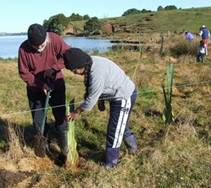9.4 What is being done?
Policy documents
The Regional Policy Statement for Northland (NRC 2002) provides an overview of resource management issues in Northland, including those with regard to lake water quality and quantity, ecosystems and biodiversity. It contains objectives, policies and methods to achieve integrated management of Northland's environment.
The objectives of the Regional Policy Statement seek to maintain or enhance water quality of Northland lakes for the purposes of aquatic ecosystems, contact recreation, water supplies and cultural and aesthetic purposes and to protect and enhance indigenous ecosystems and biodiversity.
The Regional Water and Soil Plan (RWSP) for Northland (NRC 2007) contains rules that prohibit the discharge of any sewage and animal effluent into the dune lakes as specified in the plan. Plan change 1 to the RWSP was made operative on 30 August 2007 and included changes to the rules for water takes, damming and diversions.
Lake Omapere Restoration and Management Project
The Lake Omapere Restoration and Management Project was a joint initiative between the Lake Omapere Trustees and the Northland Regional Council, funded by the Ministry for the Environment's Sustainable Management Fund. Other key stakeholders, including landowners, local iwi and hapu, Far North District Council, Department of Conservation, local schools and the local community, have also been involved in the project.
The project ran for three years with an overall aim to develop and implement a voluntary lake management strategy that will work towards improving the health of the lake and help establish the Lake Omapere Trustees in their role as Kaitiakitanga. It included developing the strategy as well as water quality and biodiversity monitoring, aquatic weed management and integrated catchment management.
 As of 30 June 2007, 85% of the margins of Lake Omapere are fenced (NRC 2007b), with more fencing planned for the 2007/2008 year. There has been several successful planting days in the lake catchment over the last thee years, with over 15,000 plants being planted.
As of 30 June 2007, 85% of the margins of Lake Omapere are fenced (NRC 2007b), with more fencing planned for the 2007/2008 year. There has been several successful planting days in the lake catchment over the last thee years, with over 15,000 plants being planted.
Planting day in 2006 at the edge of Lake Omapere.
Restoration and Management Strategy for Lake Omapere
The Lake Omapere Trustees and the Northland Regional Council have prepared a joint management strategy for Lake Omapere and its wider catchment. The Lake Omapere Trust and Northland Regional Council's Chairman formally signed the ‘Restoration and Management Strategy for Lake Omapere' on 29 September 2006, at a ceremony held at the Parawhenua Marae near the lake.
The Council and Trustees will continue to work together with landowners, the community and other stakeholders to restore Lake Omapere and work towards the targets in the strategy.
Monitoring
Resource consent monitoring
Major point source discharges to water and land require resource consent from the Northland Regional Council. Attached to the resource consent are conditions. These conditions may include provisions for effective waste treatment systems, management plans for the use of treatment systems, limits for the concentration of contaminants that are allowed to be discharged and monitoring programmes that assess the effect of the discharges on the environment.
State of the environment monitoring
In November 2005 the Northland Regional Council began monitoring 31 lakes as part of the Lake Water Quality Monitoring Network (LWQMN). Lakes in the network are monitored four times a year for a range of parameters including total and dissolved nutrients, chlorophyll α, suspended solids, water clarity, pH, temperature and dissolved oxygen. In addition to these 31 lakes, Lake Omapere is sampled at least every two months.
Lake conditional monitoring (LakeSPI) is carried out on all lakes in the LWQMN every one to five years. Weed surveillance is carried out on 11 lakes, the majority surveyed on an annual basis.
Reconnaissance surveys and water quality sampling is carried out on lakes not currently in the network to establish their ranking based on the presence of indigenous and exotic flora and fauna and water quality status. If a high ecological ranking is given to a lake and/or issues concerning the lake have been raised then the lake may be added to the LWQMN or a separate monitoring programme set up for the lake.
Other responses
Lake care groups carry out projects aimed at protecting lakes and wetlands in their area. The Bushlands Trust has started a number of restoration projects around lakes in the Kaitaia area such as planting around Lake Ngatu and Lake Heather.
The Northland Regional Council has an Environment Fund available to help people improve and protect Northland's natural environment. The fund provides up to 50% of the costs of projects protecting indigenous habitats by fencing out stock and replanting streamsides and lake margins with appropriate native plants.
